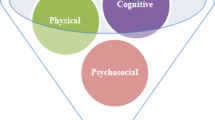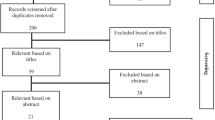Abstract
Objectives
The present study assessed a new intervention strategy to help individuals with severe to profound intellectual disability and blindness (i.e., total blindness or minimal residual vision) to travel to different rooms located on both sides of long hallways.
Methods
The intervention strategy was based on the use of a smartphone (i.e., a Samsung Galaxy J4 Plus with Android 9.0 operating system) and battery-powered light sources. The smartphone was programmed to encourage the participant to walk forward alongside a wall of the hallway until its light sensor was activated by a light source positioned before a room entrance. At that point, the smartphone encouraged the participant to stop and then enter. Nine participants were involved in the study. Each session involved seven travels.
Results
During the baseline phase, the participants’ mean frequencies of correct travels per session varied between zero and slightly above 2. During the intervention phase, with the smartphone-based cues, all participants showed a strong performance improvement. Their mean frequencies of correct travels varied between about 6.5 and (virtually) 7 per session during the second half of the intervention phase.
Conclusions
This smartphone-based intervention strategy might help support indoor travel of people with intellectual disability and blindness.


Similar content being viewed by others
References
Balboni, G., Belacchi, C., Bonichini, S., & Coscarelli, A. (2016). Vineland II. Vineland Adaptive Behavior Scales (2nd ed.). Firenze: Standardizzazione Italiana: OS.
Barlow, D. H., Nock, M., & Hersen, M. (2009). Single-case experimental designs (3rd ed.). New York: Allyn & Bacon.
Barnett, D., Hawkins, R., McCoy, D., Wahl, E., Shier, A., Denune, H., et al. (2014). Methods used to document procedural fidelity in school-based intervention research. Journal of Behavioral Education, 23, 89–107.
Bartlo, P., & Klein, P. J. (2011). Physical activity benefits and needs in adults with intellectual disabilities: Systematic review of the literature. American Journal on Intellectual and Developmental Disabilities, 116, 220–232.
Besden, C. (2007). Design and implementation of an orientation and mobility program for a young woman with multiple disabilities. Journal of Visual Impairment and Blindness, 101, 625–627.
Borg, J. (2019). Commentary on selection of assistive technology in a context with limited resources. Disability and Rehabilitation: Assistive Technology, 14, 753–754.
Brandt, M. J., Ijzerman, H., Dijksterhuis, A., Farach, F. J., Geller, J., Giner-Sorolla, R., et al. (2014). The replication recipe: What makes for a convincing replication? Journal of Experimental Social Psychology, 50, 217–224.
Brown, I., Hatton, C., & Emerson, E. (2013). Quality of life indicators for individuals with intellectual disabilities: Extending current practice. Intellectual and Developmental Disabilities, 51, 316–332.
Chebat, D. R., Schneider, F. C., Kupers, R., & Ptito, M. (2011). Navigation with a sensory substitution device in congenitally blind individuals. Neuroreport, 22, 342–347.
Cuturi, L. F., Aggius-Vella, E., Campus, C., Parmiggiani, A., & Gori, M. (2016). From science to technology: Orientation and mobility in blind children and adults. Neuroscience & Biobehavioral Reviews, 71, 240–251.
Dodds, A. G., Howarth, C. I., & Carter, D. C. (1982). The mental maps of the blind: The role of previous visual experience. Journal of Visual Impairment and Blindness, 76, 5–12.
Elsman, E. B. M., Baaj, M. A., Van Rens, G. H. M., Sijbrandi, W., Van den Broek, E. G. C., Van der Aa, H. P. A., et al. (2019). Interventions to improve functioning, participation, and quality of life in children with visual impairment: A systematic review. Survey of Ophthalmology, 64, 512–557.
Gori, M., Cappagli, G., Tonelli, A., Baud-Bovy, G., & Finocchietti, S. (2016). Devices for visually impaired: High technological devices with low user acceptance and no adaptability for children. Neuroscience & Biobehavioral Reviews, 69, 79–88.
Hagopian, L. P., Long, E. S., & Rush, K. S. (2004). Preference assessment procedures for individuals with developmental disabilities. Behavior Modification, 28, 668–677.
Hill, K., Gardiner, P. A., Cavalheri, V., Jenkins, S. C., & Healy, G. N. (2015). Physical activity and sedentary behaviour: Applying lessons to chronic obstructive pulmonary disease. Internal Medicine Journal, 45, 474–482.
Joffee, E., & Rikhye, C. H. (1991). Orientation and mobility for students with severe visual and multiple impairments: A new perspective. Journal of Visual Impairment and Blindness, 85, 211–216.
Kazdin, A. E. (2011). Single-case research designs: Methods for clinical and applied settings (2nd ed.). New York: Oxford University Press.
Kazdin, A. E. (2012). Behavior modification in applied settings (7th ed.). New York: Waveland.
Kiuru, T., Metso, M., Utriainen, M., Metsävainio, K., Jauhonen, H. M., Rajala, R., et al. (2018). Assistive device for orientation and mobility of the visually impaired based on millimeter wave radar technology: Clinical investigation results. Cogent Engineering, 5, 1. https://doi.org/10.1080/23311916.2018.1450322.
Lahav, O., & Mioduser, D. (2011). Blind persons’ acquisition of spatial cognitive mapping and orientation skills supported by virtual environment. International Journal on Disability and Human Development, 4, 231–238.
Lancioni, G. E., Oliva, D., & Bracalente, S. (1995). An acoustic orientation system to promote independent indoor travel in blind persons with severe mental retardation. Perceptual and Motor Skills, 80, 747–754.
Lancioni, G. E., Gigante, A., O’Reilly, M. F., Oliva, D., & Montironi, L. (2000). Indoor travel and simple tasks as physical exercise for people with profound multiple disabilities. Perceptual and Motor Skills, 91, 211–216.
Lancioni, G. E., O’Reilly, M. F., Singh, N. N., Sigafoos, J., Oliva, D., Bracalente, S., et al. (2007). Orientation systems to support indoor travel by persons with multiple disabilities: Technical aspects and application issues. Technology and Disability, 19, 1–6.
Lancioni, G. E., Singh, N. N., O’Reilly, M. F., Sigafoos, J., Campodonico, F., & Oliva, D. (2010a). Two persons with multiple disabilities use orientation technology with auditory cues to manage simple indoor traveling. Research in Developmental Disabilities, 31, 397–402.
Lancioni, G. E., Singh, N. N., O’Reilly, M. F., Sigafoos, J., Alberti, G., Scigliuzzo, F., et al. (2010b). Persons with multiple disabilities use orientation technology to find room entrances during indoor traveling. Research in Developmental Disabilities, 31, 1577–1584.
Lancioni, G. E., Singh, N. N., O’Reilly, M. F., Sigafoos, J., Alberti, G., Campodonico, F., et al. (2017). A technology-aided program to support basic occupational engagement and mobility in persons with multiple disabilities. Frontiers in Public Health, 5, 338. https://doi.org/10.3389/fpubh.2017.00338.
Lancioni, G. E., Singh, N. N., O’Reilly, M. F., Sigafoos, J., Alberti, G., Chiariello, V., et al. (2018). A smartphone-based technology package to support independent activity in people with intellectual disability and blindness. Internet Technology Letters, 1(5), e34. https://doi.org/10.1002/itl2.34.
Legge, G. E., Beckmann, P. J., Tjan, B. S., Havet, G., Kramer, K., Rolkosky, D., et al. (2013). Indoor navigation by people with visual impairment using a digital sign system. PLoS ONE, 8(10), e76783. https://doi.org/10.1371/journal.pone.0076783.
Luiselli, J. K., Bass, J. D., & Whitcomb, S. A. (2010). Teaching applied behavior analysis knowledge competencies to direct-care service providers: Outcome assessment and social validation of a training program. Behavior Modification, 34, 403–414.
Makel, M. C., & Plucker, J. A. (2014). Facts are more important than novelty: Replication in the education sciences. Educational Researcher, 43, 304–316.
Papadopoulos, K., Koustriava, E., Koukourikos, P., Kartasidou, L., Barouti, M., Varveris, A., et al. (2017). Comparison of three orientation and mobility aids for individuals with blindness: Verbal description, audio-tactile map and audio-haptic map. Assistive Technology, 29, 1–7.
Parker, A. T. (2009). Orientation and mobility with persons who are deaf-blind: An initial examination of single-subject-design research. Journal of Visual Impairment and Blindness, 103, 372–377.
Pedhazur, E., & Schmelkin, L. (1991). Measurement design and analysis: An integrated approach. New York: Psychology Press.
Pierce, W. D., & Cheney, C. D. (2008). Behavior analysis and learning (4th ed.). New York: Psychology Press.
Ross, D. A., & Kelly, G. W. (2009). Filling the gaps for indoor wayfinding. Journal of Visual Impairment and Blindness, 103, 229–234.
Scherer, M. J., MacLachlan, M., & Khasnabis, C. (2018). Introduction to the special issue on the first global research, innovation, and education on assistive technology (GREAT) summit and invitation to contribute to and continue the discussions. Disability and Rehabilitation: Assistive Technology, 13, 435–436.
Siegel, S., & Castellan, N. J. (1988). Nonparametric statistics (2nd ed.). New York: McGraw-Hill.
Smith, R. O., Scherer, M. J., Cooper, R., Bell, D., Hobbs, D. A., Pettersson, C., et al. (2018). Assistive technology products: A position paper from the first global research, innovation, and education on assistive technology (GREAT) summit. Disability and Rehabilitation: Assistive Technology, 13, 473–485.
Sparrow, S., Cicchetti, D., & Balla, D. (2005). Vineland-II adaptive behavior scales (2nd ed.). Minneapolis: Pearson.
Taylor, M. J., Taylor, D., Gamboa, P., Vlaev, I., & Darzi, A. (2016). Using motion-sensor games to encourage physical activity for adults with intellectual disability. Studies in Health Technology and Informatics, 220, 417–423.
Uslan, M., Malone, S., & De l’Aune, W. (1983). Teaching route travel to multiply handicapped blind adults: An auditory approach. Journal of Visual Impairment and Blindness, 77, 18–20.
Uslan, M., Russell, L., & Weiner, C. (1988). A ‘musical pathway’ for spatially disoriented blind residents of a skilled nursing facility. Journal of Visual Impairment and Blindness, 82, 21–24.
Vornholt, K., Uitdewillingen, S., & Nijhuis, F. J. N. (2013). Factors affecting the acceptance of people with disabilities at work: A literature review. Journal of Occupational Rehabilitation, 23, 463–475.
Wright, T., Harris, B., & Sticken, E. (2010). A best-evidence synthesis of research on orientation and mobility involving tactile maps and models. Journal of Visual Impairment & Blindness, 104, 95–106.
Zhu, J., Li, Q., Cao, R., Sun, K., Liu, T., Garibaldi, J. M., et al. (2019). Indoor topological localization using a visual landmark sequence. Remote Sensing, 11, 73. https://doi.org/10.3390/rs11010073.
Author information
Authors and Affiliations
Contributions
GL was responsible for setting up the study, acquiring and analyzing the data, and writing the manuscript. MO, JS, LD, GA, VC, and AN collaborated in setting up the study and/or analyzing the data and writing/editing the manuscript.
Corresponding author
Ethics declarations
Conflict of Interest
The authors declare that they have no conflict of interest.
Ethical Approval
Approval for the study was obtained from the Ethics Committee of the Lega F. D’Oro, Osimo, Italy. All procedures performed were in accordance with the ethical standards of the institutional and/or national research committee and with the 1964 Helsinki Declaration and its later amendments or comparable ethical standards.
Informed Consent
Written informed consent for the participants’ involvement in the study was obtained from their legal representatives.
Additional information
Publisher’s Note
Springer Nature remains neutral with regard to jurisdictional claims in published maps and institutional affiliations.
Rights and permissions
About this article
Cite this article
Lancioni, G.E., O’Reilly, M.F., Sigafoos, J. et al. Smartphone-Based Technology to Help Individuals with Intellectual Disability and Blindness Manage Basic Indoor Travel. Adv Neurodev Disord 4, 430–438 (2020). https://doi.org/10.1007/s41252-020-00169-4
Published:
Issue Date:
DOI: https://doi.org/10.1007/s41252-020-00169-4




